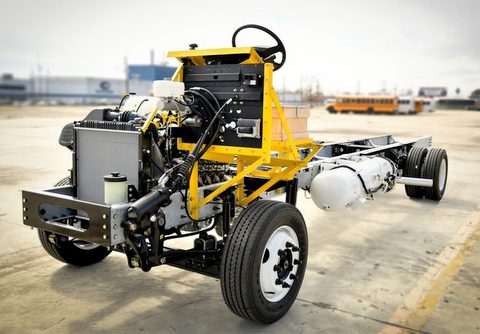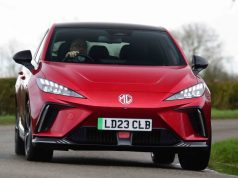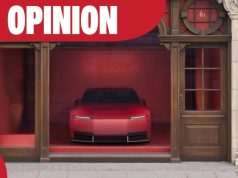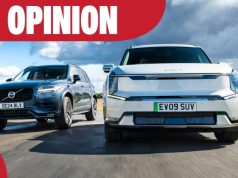The Latest Developments in Low and Zero-Emission Commercial Vehicles
The largest coming together of the clean energy industry for commercial vehicles, ACT Expo 2025 (for Advanced Clean Transportation) was held this past week in Anaheim, California. The enthusiasm was high on the technology that moves the heaviest trucks on the road and brings everything we use in our daily lives. As Jimmy Hoffa, the late president of the International Brotherhood of Teamsters said, “If you got it, a truck brought it to you.” But the change in administration in Washington, D.C., and the shift in priorities that has come along with that also cast a shadow on an event that has focused heavily on zero-emission vehicles in recent years.
This year’s show had several announcements on battery electric, plug-in hybrid electric and fuel cell electric vehicles. In alphabetical order, this is some of what we saw.
Blue Bird
Almost everyone has seen a bright yellow school bus rolling along with kids inside bobbing up-and-down. Since its founding in 1927 Blue Bird has been one of the largest suppliers of school buses in the country, but they also manufacture other vehicles, such as transit buses, motorhomes, mobile libraries and police command centers. At ACT Expo 2025 they showcased zero and ultra-low emission commercial vehicle platforms using either electricity or propane.
The company’s electric-powered step van is designed for last mile deliveries with an all-electric driving range of 130 miles. A full charge can take up to 12 hours with Level 2 charging.
Its propane-powered vehicles are designed for medium to long-range deliveries. Blue Bird uses the Roush CleanTech ultra-low emission propane technology that they say “has accumulated more than three billion miles with 3,000 fleets in North America.”
Harbinger
Harbinger showed its all-new plug-in hybrid commercial vehicle, which is an electric vehicle with a gas-powered range extender. The Harbinger stripped chassis was designed for medium-duty vehicles such as delivery vans, box trucks, recreational vehicles and other uses.
The gasoline and electric combination charges the battery when driving, providing an estimated 500 miles driving range. The 1.4-liter inline four-cylinder gasoline engine is mated to an 800V generator and a 50-gallon fuel tank good for up-to 440 horsepower.
Deliveries to commercial customers begin in 2026.
Hyundai
Hyundai held a very well-attended press conference spotlighting its Xcient hydrogen fuel cell Class 8 truck that is now equipped with Plus AI-based autonomous driving software. The goal of the partnership is to develop a “cost-effective solution to long-haul freight that aims to reduce the carbon footprint of commercial transportation.” To reach this goal they will be deploying trucks on major freight routes to expand the network of hydrogen fueling stations and to grow the wider use of hydrogen/electric trucks, regardless of the manufacturer.”
The company’s second announcement was on the decarbonization of emissions at the electric vehicle production Hyundai Metaplant in Savannah, Georgia, and in the Port of Savannah. The company is building-out a hydrogen production and refueling station 10 miles from the Port of Savannah, which is one of the busiest freight ports in the U.S. They will also be building a commercial vehicle electric charging station.
Hyundai will add refueling stations for its hydrogen-powered
Jim Park, senior vice president, commercial vehicle and hydrogen fuel cell business, Hyundai Motor North America, told the press conference attendees: “This is a breakthrough for hydrogen production and refueling stations for the heavy-duty trucking industry, allowing zero-emissions trucks to quickly and easily refuel at a single convenient location in the Savannah region.” Park finished with: “The Savannah hydrogen station will also truly fulfill our vision for our innovative new electric vehicle plant to transport plant shipments within a clean, zero-emissions ecosystem.”
Operations are scheduled to begin in late Fall 2025.
The FCEV Xcient rolls quietly
Kenworth
Kenworth debuted two new electric trucks, the T680E Class 8 semi truck and the T880E, which Kenworth calls its vocational Class 8 truck.
The T680E and T880E both feature ground-up developed ePowertrains that deliver between 365-470 continuous horsepower (hp) and 1,850 pound-feet of torque.
There are four battery-string options offering all-electric driving range (AER) of 100 to 250 miles, with a 90% DC Fast Charge in two hours.
Nick Harker, systems chief engineer, who is responsible for product development for zero emissions, told us, “We have been working on this generation of electric trucks for five years and have been in production of the earlier generation for two years. However we have been working on electrified trucks for more than 15 years. This includes our Supertruck2 we showed at ACT Expo 2024 that had a mild hybrid (a diesel/electric hybrid).”
He went on to say: “This generation of (electric) powertrain allows us to do a unique chassis and be flexible to work in many different applications, such as a flatbed, dump truck or even a tractor pulling trailers. But the biggest thing we do is make sure a battery electric powertrain is right for their application.”
Love’s
The national network of company-owned travel stops are unique, serving both the professional driver and the motoring public. The offerings include self-serve gasoline and diesel as well as having a country store, a name brand restaurant at some locations, a tire center and trucker amenities.
Love’s announced at ACT Expo it had rebranded the Trillium Energy Solutions, a provider of alternative fueling options, as Love’s Alternative Energy, offering EV charging, hydrogen, compressed natural gas (CNG) and low carbon renewable natural gas (RNG). This is significant for over-the-road truckers and families on a road trip in their recreational vehicle, car, pickup or SUV.
The CNG network totals 107 locations nationwide and in Canada, with all of the U.S. CNG stations supplied with 100% renewable natural gas (RNG). Within hydrogen, the company is building stations or operates six hydrogen locations across the country and has invested in building a heavy-duty hydrogen vehicle fueling station. Future hydrogen plans include designing and building-out the hydrogen network. For EV charging, Love’s recently installed next-generation chargers at two stores in New York and three in Pennsylvania and will continue building out the EV charging infrastructure across the country. Clean Fleet Report used one of Love’s DC Fast Chargers on our 1,796-mile road trip from California to Moab, Utah, in a Ford Mustang Mach-E. We found the charger fast and reliable, the country store well stocked and the restaurant and restrooms clean and convenient.
Mack Trucks
Prominent in the Mack Truck display at ACT Expo was its 2026 Mack Pioneer Class 8 diesel-powered truck. Of course, at a clean propulsion convention this would seem odd, until Mack said it uses “cleaner diesel, has improved fuel economy, lower carbon emissions, including nitrous-oxide, and lower operating costs.” Mack touted the Pioneer can run on HVO (hydrotreated vegetable oil) fuel or renewable diesel. It has the same chemical and physical properties as fossil diesel fuel, but with lower carbon content.
The press conference crowd didn’t go away completely disappointed as Volvo Group (Mack’s parent company) had a slideshow presentation of the all-new Mack Pioneer Electric Class 8. With an estimated 300 all-electric mile range and DC Fast Charging to 80% in less than 90 minutes, it is designed for regional hauling, drayage and hub-and-spoke operations. Since all of these are primarily in cities, the zero-tailpipe emissions from the latest generation Proterra batteries should go a long way to keep the air cleaner.
Mack Pioneer Electric deliveries are expected sometime in early 2027.
Volvo
Volvo showed its VNR Electric that has up-to a 275 all-electric mile driving range and a 90 minute 80% DC Fast Charge. Volvo claims it is: “The global leader in zero-emission electric trucks, is committed to reducing pollution, noise and traffic on crowded urban streets.”
The drivetrain is rated at 455 hp with up to 4,051 lb./ft. of torque mated to the company’s two-speed I-Shift automated transmission. The VNR was designed to accommodate all of the powertrains that Volvo might offer—diesel, CNG, H2 ICE, EV and fuel cell, all aided by the truck’s emphasis on design aerodynamics.
Volvos says: “The VNR Electric has been redefined to meet the needs of drivers operating in today’s competitive marketplace. Improved seating, instruments and controls are designed to put the driver comfortably and safely in command.”
Sales are expected in late 2025.
Voltera
A developer, owner, and operator of 21 charging facilities in the U.S., Voltera announced the addition of 294 charging stalls in Santa Monica and San Francisco, California, and Dallas and Austin, Texas. The company also said new facilities are opening soon in Houston, Texas; Phoenix, Arizona; and Miami, Florida. These Voltera facilities are for zero-emission vehicle fleets, primarily light-duty passenger vehicles.
Voltera, founded in 2022, also serves the drayage fleets operating out of the Ports of Long Beach and Los Angeles with its newly opened (February 2025) Lynwood EV Charging Facility that went from dirt to operation in a short 18 months. Lynwood sits right off the 710 Freeway, a major corridor for trucks moving goods between the ports and inland distribution centers in Southern California.
WattEV
A California-based vertically integrated company, WattEV used ACT Expo to mark a milestone in its goal of accelerating the transition to battery-electric vehicles. Its fleet of about 80 electric Class 8 trucks is currently achieving more than 75,000 miles a week of commercial service. The company has accumulated more than three million zero-emission miles on its growing fleet that recently added two Tesla Semis, one of which was on display at the conference.
The company’s tactic is to “combine an innovative truck-as-a-service (TaaS) model to engage owner-operators and small fleets, offer transport services for shippers and carriers as well as providing state-of-the-art charging infrastructure” that includes pricing that creates total cost of ownership on par with diesel.
The environmental aspect of their business plan is intriguing as it makes “the switch to electric vehicles available to both large and small fleets and owner-operators by building a network of strategically-located charging stations along major truck corridors and developing projects with on-site solar generation.”
The company has five locations currently in California with 15 more in development in the network that will initially service the entire West Coast of the U.S.
Make sure to opt-in to the Clean Fleet Report newsletter (top right of page) to be notified of all new stories and vehicle reviews.
Story by John Faulkner. Photos by John Faulkner and the manufacturers.
The post Event: 2025 ACT Expo first appeared on Clean Fleet Report.







